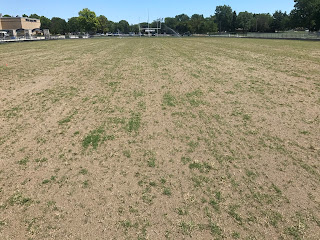Practice began on the new surface on August 1, 2017. The first game took place on August 18,
2017. The surface had a shear strength
in excess of 30 ft lbs. We knew it would
play well, but even our team was surprised by the results.
Here is the field in mid September after 10 events.
Per the plan, the surface was overseeded with Barenbrug HGT
Bluegrass in early September with a goal of creating a “Bluemuda” playing
surface. A small amount of ryegrass was
added for additional color. Here is what
the soccer goal area looked like after the soccer season.
Here is a recap of the grow-in.
The playing surface hosted 50 events (games and practices) from August 1 – Nov 1, 2017. Why was it successful?
1.
The new
surface had a good surface grade.
2.
The new drainage system provided a “rain out
proof” playing surface, thus there was never a rain game to tear up the
surface.
3.
A blend of warm season and cool season turf
provided superior shear strength and wear tolerance to extreme play.
In conclusion, a $130,000 investment provided a rain out
proof surface that hosted 50 games and practices in fall 2017. Quite the return on the investment.
Go to j-dturf.com to learn more about J&D Turf.
Play on!
--Jamie
@JamieMehringer












































